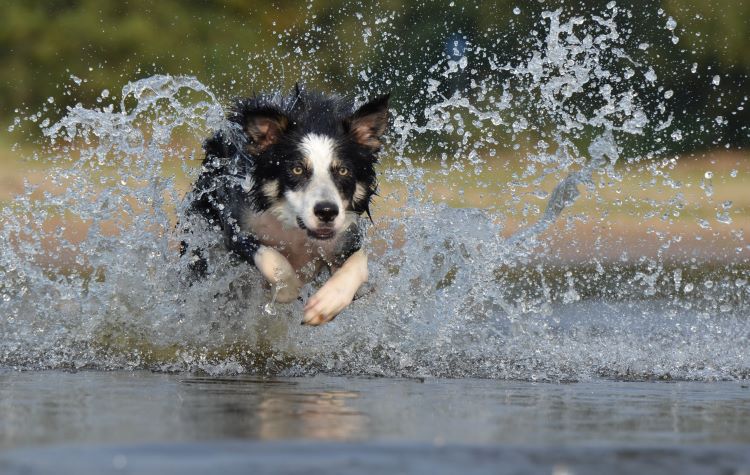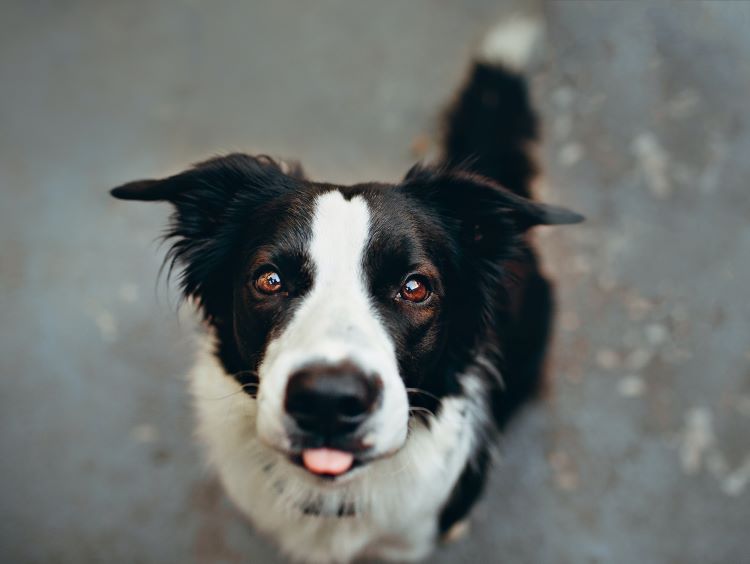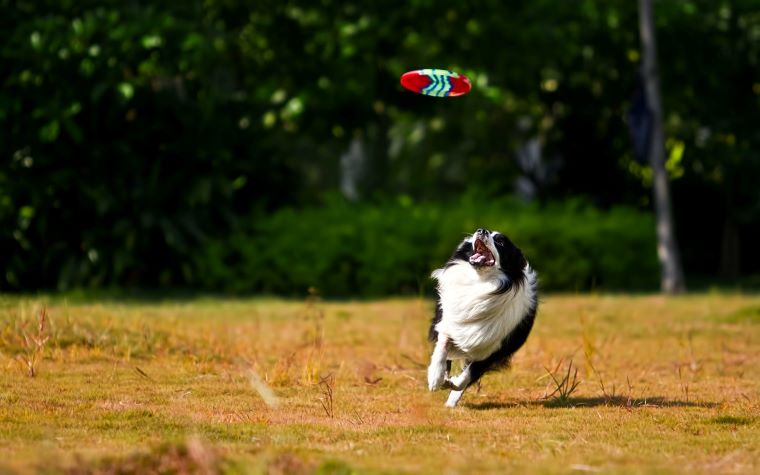Ready to help treat your pet to a healthy life?
All About the Border Collie Breed
By : Trupanion Staff | Updated Feb 15, 2024

Wondering if a Border Collie is the right pet for you? This breed guide offers a comprehensive look at this smart and agile dog. Whether you're looking for a fun family companion or a capable working dog, the Border Collie may be a good fit. That said, it's important to know what you're getting into in order to provide the best life possible for your pet and ensure you are compatible.
Fun facts about Border Collies
- Border Collies are extremely intelligent. Chaser, a purebred Border Collie, became known as “the smartest dog in the world” after she learned more than 1,000 nouns. Her owner, Dr. John Pilley, a retired psychologist, wrote a book about Chaser, dog intelligence, and the method he used to unlock her potential.
- The classic herding behaviors of the Border Collie — crouching, stalking, staring, and driving the prey towards packmates — are simply modified hunting behaviors, called the predatory sequence. Herding breeds have evolved, with the help of selective breeding, to practice the first steps of the predatory sequence, without the usual ending of actually killing the prey.
- Border Collie Neo earned the nickname “The Parkour Collie” after earning the Guinness World Record for Fastest 10 Hoop Slalom by a Dog. He weaved and jumped through the hoops in just 8.58 seconds.
- Border Collies are a more recent addition to the American Kennel Club’s list of recognized breeds, joining the Herding Group in 1995.
- Border Collies aren’t the only Collies on the block. They share this name with simply named Collie and the Bearded Collie. “Collie” is a Scottish term to describe sheep herding dogs. The Border Collie is so named because it originated along the border of Scotland and England.
- All modern Border Collies can trace their lineage back to Old Hemp, a Border Collie used as a stud dog in the late 1800s. Old Hemp was known for his even-temperament and quiet, yet effective, herding skills. He sired over 200 Border Collie puppies in his lifetime — quite the busy guy!
About the breed
All Border Collies are individuals and come with their own personalities and preferences. However, there are general traits that can be observed across the breed.

Physical features
- Flexible shoulders with extra space between the shoulder blades. This allows them to crouch and slink close to the ground while herding.
- A particularly intense stare, called “eye.” Useful in herding, this staring helps to intimidate and then control the movement of the sheep or other livestock.
- 30 to 55 pounds
- 18 to 22 inches tall
Personality
A Border Collie is rather single-minded — it’s all about work! This breed is happiest when they have a task to do. Their favorite activities involve working as a team with their person. This makes Border Collies ideal dogs for active lifestyles and dog sports, especially agility. Intelligent and independent, a Border Collie wants to save the cuddling for after their workday is over. Their brain is always going and they are very responsive to their environment. Border Collies need their rest so they don’t become high-strung and nervous. Providing a calm resting place and sufficient “downtime” is crucial for this breed.
Similar breeds to the Border Collie
- Australian Shepherd
- Collie
- Bearded Collie
- Australian Cattle Dog
- Icelandic Sheepdog
History of the Border Collie
Border Collies are descendants of dogs brought to Britain by the Romans to guard and herd the livestock that came with them. These Roman dogs weren’t ideal for the highland terrain of Scotland and Wales, and over time shepherds created better-suited herding dogs. As the Roman empire dissolved, Viking invaders introduced their spitz-type breeds to the British Isles. When crossed with the larger Roman dogs, the results were perfect for the rough terrain and cold climate. These dogs were the foundation for our modern-day Border Collies.
While integral in the lives of Scottish and Welsh shepherds for centuries, it wasn’t until the end of the 19th century that the Border Collie breed was truly refined. Old Hemp, a Border Collie born in 1893, is considered the father of the breed. Owned by Adam Telfer of Northumberland, Old Hemp had a quiet yet intense working style compared to other Collies of the time. His herding style became highly sought after, and he is said to have sired more than 200 puppies before he passed away in 1901.
Lumped in with other Scotch Collies of the time, the term Border Collie was first used in 1915 to distinguish them from the Collie and Bearded Collies. Primarily bred for working ability and registered with the International Sheep Dog Society rather than the Kennel Club, the Border Collie wasn’t big in the show ring for quite some time. In fact, the Border Collie didn’t officially join the American Kennel Club’s herding group until 1995, after spending 50 years in the miscellaneous group.
Caring for a Border Collie
A Border Collie can have one of two types of double-coat: a longer rough coat or a shorter smooth coat. This breed can have any coat and eye color, including merle patterns. The most common color seen in Border Collies is black and white.
A Border Collie needs regular brushing, especially if they have a longer coat, to prevent tangling and keep their skin and fur healthy. While average shedders, you might notice an increase of shedding during seasonal “blowing of coat,” which tends to be twice a year during spring and fall. Brushing more frequently during these times will help keep the furballs around the house to a minimum.
Enrichment and exercise needs
Border Collies were bred for stamina to herd all day. As such, they need more than a daily jog or a game of fetch to burn off their excess energy. Aim for at least one hour of physical exercise paired with lots of mental enrichment and brain games. Participation in active dog sports that let your Border Collie run will go a long way in providing the exercise they need (both for their bodies and their brains!).
That being said, it’s important to provide a Border Collie with time to rest and recharge. Their herding instincts mean that they are very responsive to movement and other environmental stimuli. If they are constantly bombarded with activity, they can become overstimulated, nervous, and reactive. After a long day at work, make sure they have a quiet and calm place to relax and recover.
Speak with your veterinarian about appropriate exercise for a Border Collie puppy. Until they are full-grown (bone growth plates typically all close by around 1 year of age), avoid strenuous or repetitive activities like jogging or running — as this can increase their risk of damage to the growing bone and cartilage, causing pain and future joint issues.
Mental enrichment and brain games will help you meet the extensive physical exercise needs of a Border Collie. Put their brains to work with puzzles, work-to-eat toys, training games, flirt pole play, and scent work activities. Mental exercise burns excess energy and will prevent your Border Collie from finding their own job to do. Border Collie puppies especially benefit from enrichment and puzzles as they grow up.
Border Collies excel in many different activities:
- Herding / Treibball
- Agility
- Nosework
- Disc Dog
- Canine Freestyle
- Rally Obedience
- Search and Rescue
- Trick Training
Border Collie behavior and training
Border Collies are not for the faint of heart. This breed requires a huge commitment of time and energy to meet their working dog needs. But if you have the energy and can handle sometimes being outsmarted by your dog, you’re in for an amazing experience. These dogs are eager to please, making training fun. Many Border Collies are more toy and play-oriented than food motivated. Use positive reinforcement training to build a strong working relationship with your Border Collie.

How do Border Collies do with others?
Border Collies can be good with strangers, but they can be picky about whom they are friendly with. They also don’t usually enjoy their space being invaded. Set your Border Collie up for success by practicing positive socialization and handling exercises from puppyhood and continued positive training through adulthood. Proper proactive exposure to new sights, sounds, people, dogs, and other animals as a young puppy is essential for their future socialization skills.
This breed’s natural herding instincts can make living with younger children difficult. They will do better with older children that don’t run around or squeal, which often triggers herding and nipping behavior. However, they can make wonderful family dogs if socialized with children from puppyhood and given appropriate outlets for their herding instincts. Children should always be taught how to interact with dogs in a respectful and polite way to help keep everyone safe. Young children and dogs should always be supervised, and it’s helpful for a dog to have their own “safe space” where they can go when they need some quiet time.
Border Collies will do well with other animals in the home if they are properly socialized from puppyhood, and if their herding instincts are directed to appropriate activities.
Border Collies in pop culture
The high stamina and trainability of these dogs make them great pets for energetic pet owners and good co-stars for human actors.
Famous owners of the Border Collie
- Ethan Hawke (Actor)
- Anna Paquin (Actress)
- Jon Bon Jovi (Singer)
- Robert Burns (Poet)
- Queen Victoria (Royalty)
- James Dean (Actor)
Famous Border Collies
Chaser, who is known as the smartest dog in the world, has even impressed Neil deGrasse Tyson
Border Collies in movies and TV
- Devon from A Dog Year
- Fly (and the other sheep dogs) from Babe
- Nana the Border Collie from Snow Dogs
- Murray (Border Collie mix) from the show, Mad About You
- Bandit in Little House on the Prairie
